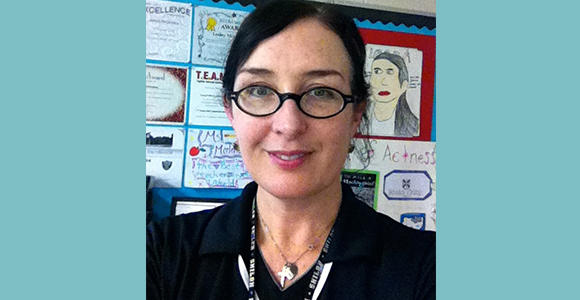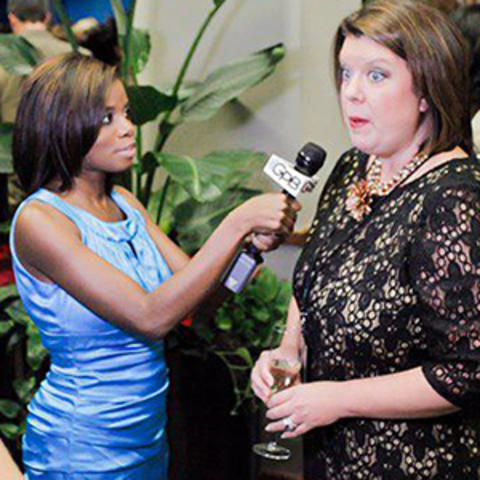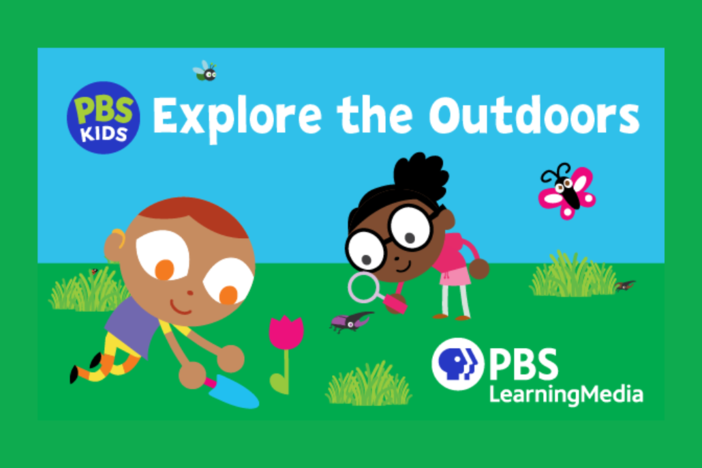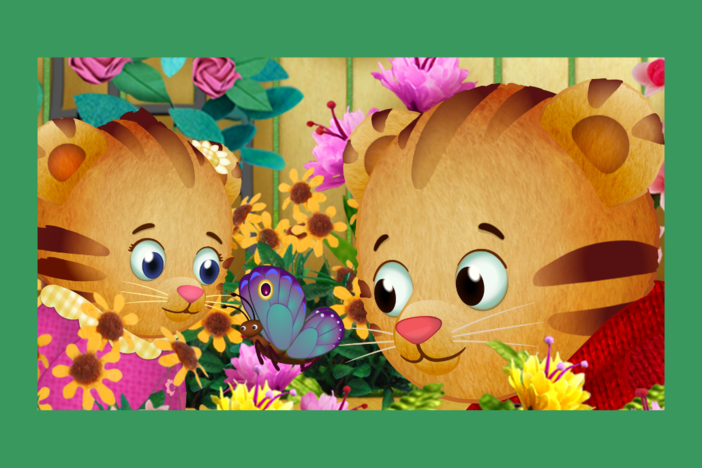
Section Branding
Header Content
Profile: Georgia PBS Digital Innovator Lesley McClendon
Primary Content

This week one of our PBS Digital Innovators, Lesley McClendon, goes to PBS headquarters in Arlington, Va to attend the PBS LearningMedia Digital Innovator Summit. It is being held June 19-20, 2014.
McClendon was tapped to attend because she received the additional honor of being named a top 16 “Lead PBS Digital Innovators.” While in Virginia, she’ll meet other nationally recognized teachers, attend sessions led by digital education experts and get tours of D.C. museums and sites.
We will join her to cheer her on, document the activities and gain updates on PBS LearningMedia features that we’ll both share with you in the upcoming school year.
She will also contribute blogs on how she’s spending her summer serving the Reach for Excellence program.
McClendon hails from Roswell and teaches 7th grade Special Education/Language Arts at Shiloh Middle School in Atlanta.
She has a B.A. in English from Rhodes College in Tennessee and is pursuing her M.Ed in Reading, Language and Literacy at Georgia State University. She considers herself a new teacher but has been teaching for seven years.
In this email exchange, she talks about why she became a teacher, the classroom tech tools she uses everyday and what the 21st century classroom should look like.
Passion for Learning: What inspired you to pursue teaching?
McClendon: I grew up in a family of readers, so even from an early age, I was surrounded by books. Also, my mother was a teacher, and I remember my excitement at visiting her early elementary classroom when I was a child. She was passionate about working with young readers, and her dedication remains a strong inspiration for me today.
Reading is definitely a passion of mine - I don’t go anywhere without a book! As a teacher, I want to foster among my students, especially those who are struggling readers, this same type of excitement and appreciation for reading.
Passion for Learning: How does it feel to be selected as a PBS LearningMedia Digital Innovator and as a lead teacher?
McClendon: To say that I was excited to learn of this recognition would be an understatement! I feel so honored to be a part of this amazing group of educators, and I’m looking forward to learning from them.
Passion for Learning: What do you hope to accomplish as being part of the program?
McClendon: My passion for literacy is equaled by my interest in incorporating technology in the classroom, so as a PBS Digital Innovator, I hope to learn new strategies for technology use that I can implement in my own instruction and also share with teachers.
I’m sharing digital literacy strategies as a presenter at several conferences this summer, and I’m eager to build upon those experiences to develop my ability to become a teacher leader in my school and community.
Tech Tools She Uses and Recommends
Passion for Learning: What tech tools would we find in your classroom and what would students be doing with them?
McClendon: Students use some form of technology each day in my classroom to practice reading, writing and speaking/listening skills. At the beginning of class, you would likely observe students using the Padlet app on laptops and smart devices to create written responses to a text or visual prompt. We also use Padlet to involve everyone in the activities of brainstorming ideas for writing and posting opinions with text evidence.
Google Earth Tour Builder is an exciting interactive digital storytelling tool that my students enjoy using with their laptops. The app offers amazing Google Earth views and students posting their writing on a class tour can add images and videos to make their stories come alive. Another favorite Google activity of students is the use of the GeoGuessr app to practice making inferences.
Students use laptops and smart devices to access interactive learning modules called Thinglinks, which enable them to learn by exploring and responding to web resources at their own paces. Students also create their own Thinglinks when evaluating images, videos, and texts as they research topics.
Students work in small groups to practice their reading fluency at a MacBook station, using the GarageBand app to record themselves reading aloud. After converting their audio files into QR Codes, students listen to their reading and evaluate their fluency progress. Students also use digital tools to create graphs representing the results of their reading fluency practice, enabling them to self-monitor their progress toward student-created reading goals.
The most popular learning activities include using an iPad to create videos of book talks, which students then use to create book trailers with iMovie. They also embed student-created videos in Aurasma augmented reality auras, which can serve as tutorials or as an engaging means of sharing comments on a text.
I’m already excited about tech possibilities for next school year! I plan to explore the use of blogging and social media to engage students in literacy activities and I want to learn how to use Skype so that we can learn from making connections with students and authors from across the country.
On Working at a BYOD (Bring Your Own Device) School
Passion for Learning: You teach at a BYOD school. How did that program come about and how do you manage it?
McClendon: The BYOD program at Shiloh Middle is part of Gwinnett County Public Schools’ e-Class initiative and aims to support learning through the student use of digital tools. I was fortunate to partner with Mr. Jay Barbour, one of the Assistant Principals at Shiloh Middle, to participate in the initiative as a teacher for a pilot BYOD classroom.
I’m presently completing a M.Ed. in Reading, Language, and Literacy at Georgia State University, where my research focus relates to the implementation of digital literacy practices. We realized that the BYOD program was a perfect opportunity for us to explore the potential of technology use as it relates to the development of student literacy skills. My school also provided a class set of laptops to supplement student devices.
Learning to manage devices in a BYOD program is no small task! When reflecting upon my initial experience with leading a BYOD classroom, however, I feel proud of the responsible attitudes and actions my students demonstrated over the course of the school year. A key to the successful management of the devices is to create and consistently communicate specific expectations for the use of technology. My students also likely made a special effort to act responsibly simply because they were so excited and appreciative of the opportunity to use technology and to become recognized as student tech leaders in their school!
Passion for Learning: What are some of the challenges you’ve faced as an educator enthusiastic about utilizing technology in your teaching?
McClendon: Well, all educators have likely had the unwelcome experience at one time or another of a planned activity that just doesn’t work out as expected, or of a tech glitch that threatens to interrupt the pace of a lesson . . . at least I know that I have!
Passion for Learning: How have you overcome them and what advice would you give to teachers and parents about those same challenges?
McClendon: It’s important to me in general to create a classroom culture in which risk-taking is encouraged and mistakes are accepted as a positive part of the learning process. I’ve come to realize that this mindset is especially important to maintain when I’m experiencing a challenge with technology.
I’ve learned that such challenges can actually become wonderful opportunities for students to practice problem solving. In fact, my students love it when I come to them for a tech solution or ask them to figure out a new app. We also use challenges as an opportunity to identify the qualities that we look for in apps and technology. We are learning to use this information as a framework for evaluating apps and deciding as a group whether they are appropriately meeting the needs of our classroom.
On What the 21st Century Classroom Should Look Like
Passion for Learning: What do you think the 21st century classroom should look like?
McClendon: It’s an exciting time to be a teacher, for digital tools are literally changing the ways that students are reading and writing. Instruction is shifting away from the old school “give and get” lectures toward a new understanding of learning that is rooted in technology and based in the concept of making meaning through the processes of exploring and creating.
In the 21st century classroom, learning is student-centered and project-based; learning expands beyond the walls of the classroom so that students can develop communication skills and embrace knowledge of the global community.
Passion for Learning: What are some of your favorite PBS Learning Media videos, images and games that you recommend?
McClendon: I’ve found a variety of PBS LearningMedia resources to be helpful in supplementing thematic units and providing background knowledge for students.
When my students are learning about the Holocaust, the video "Author Francine Prose Unlocks the Life and Diary of Anne Frank" provides an interesting means for them to learn little known facts about Anne Frank and to shape their own perspectives of text from her diary. They also view "The Diary of Anne Frank" video, which brings the entries of Anne’s diary to life with dramatizations of her life in hiding.
When my 7th graders recently read the novel Seedfolks, by Paul Fleischman, they benefitted from viewing the “Community Gardens” video to learn about the ways that gardening can positively impact a community. Students were also able to use video content to make “media to self” connections to their own communities.
Secondary Content
Bottom Content





